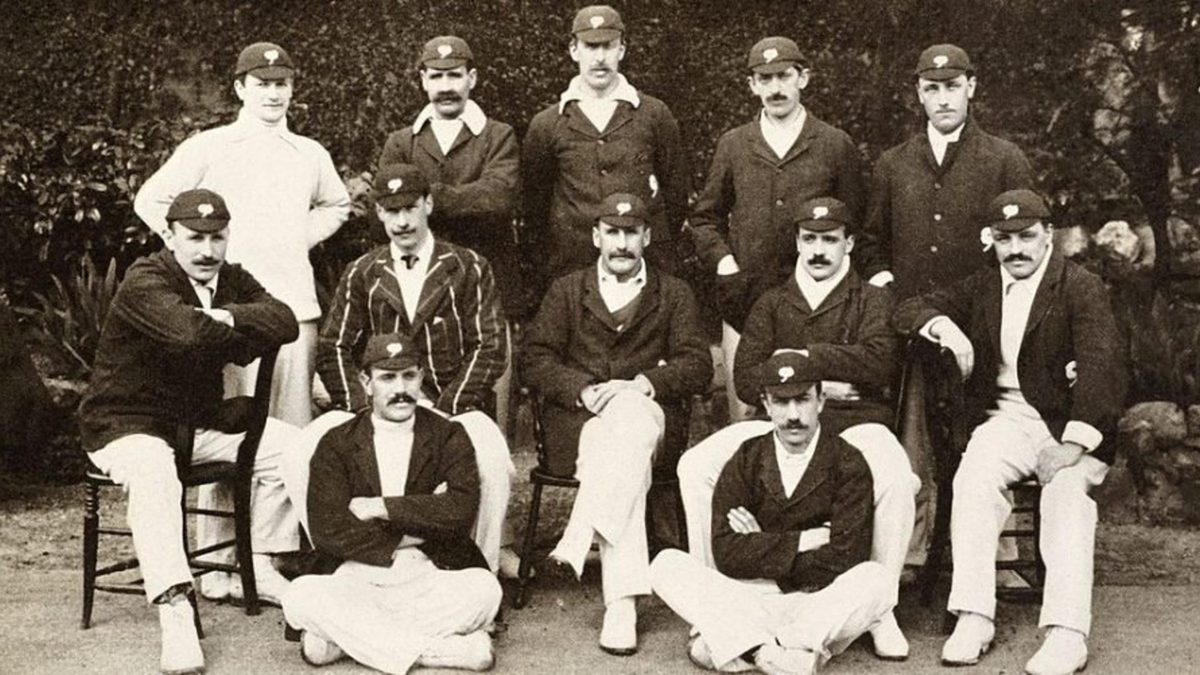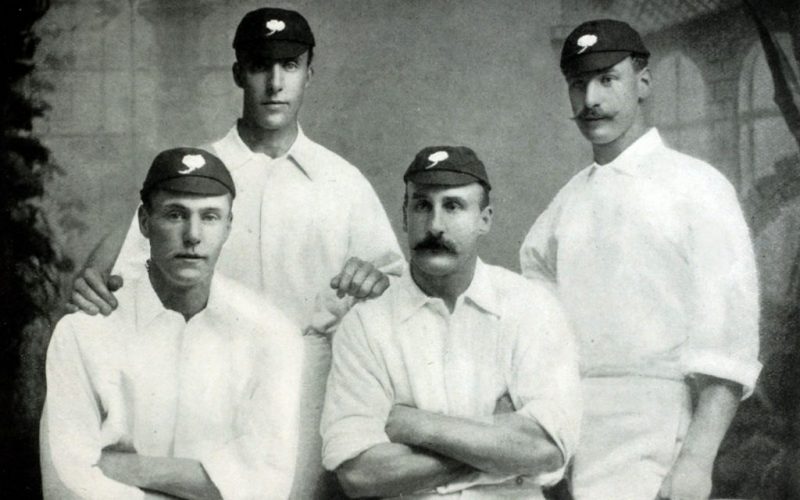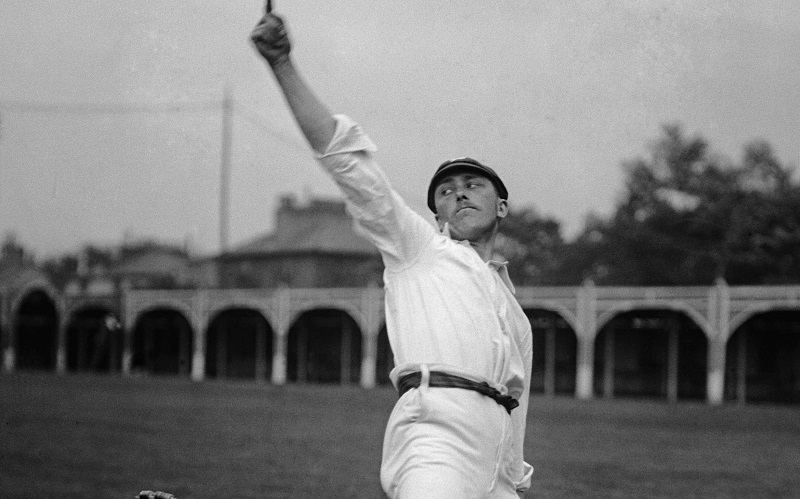
In the maze of seminar rooms, hospitality suites and lecture theatres which fill Headingley’s huge, glass-fronted Carnegie Pavilion there is an area which actually belongs to Yorkshire County Cricket Club. Although as modern in design as the rest of the new building, it harks back to the era in which cricket became the county’s secular faith. It is the Lord Hawke Suite.
Paul Edwards takes us back to the first Golden Age for Yorkshire, when Lord Hawke turned a group of carousers into an indomitable team that set new standards for professionalism. First published in May 2016
On one wall of the room in which officials entertain their guests is a portrait of the Hon. Martin Bladen Hawke, under whose captaincy Yorkshire won the 1893 title, their first since the counties had agreed a system for deciding the champions in 1890. Hawke is wearing the Yorkshire colours – Cambridge blue and Oxford blue and gold – which were adopted under his leadership; they were also the Hawke colours. He also instituted the white 11-petalled badge which was only to be worn by capped players. But Hawke’s importance extended far beyond style and symbolism; there were to be seven more titles in the space of 13 seasons under his captaincy. Alongside that painting is printed Sir Pelham Warner’s assessment of Hawke’s leadership: “Under his guidance the Yorkshire XI were looked on as the model of what a county side should be, well disciplined, well-drilled and efficient.”
It had not always been so. Hawke’s reign as Yorkshire’s uncrowned monarch had begun in 1883 and was to last for 28 seasons. In its early years he only played outside the Cambridge terms and in 1885 he did not appear in a single county match. The Yorkshire side of that era was indisputably talented but undisciplined. It was said that opening batsman, Louis Hall, a Nonconformist lay preacher, was the first teetotaller to play for the county and that Hawke had been given the task of skippering nine drunks and a chapel parson. A few Yorkshire players in the 1880s were not so much well-drilled as frequently hammered.
By the end of the decade Hawke had observed enough. After the 1889 season, in which Yorkshire had won two county games and lost 10, he began one of the few sporting revolutions led by a toff. Four players were dismissed and new habits insisted upon as autocracy replaced anarchy. As Derek Birley points out: “[Hawke] set about the task of instilling discipline and sobriety into his wayward troops and soon Yorkshire, restored to feudalism, were ready to play the establishment game.”
Yet Hawke was a curious choice as Yorkshire captain; for one thing, he was not even a Yorkshireman. Born in Willingham Rectory in Lincolnshire in 1860, his qualification was based on the fact that by 1878, when he was playing for Eton against Harrow at Lord’s, his family was based at Wighill Park, near Tadcaster. Hawke’s involvement with the county began through the York-based Yorkshire Gentlemen’s CC, one of whose leading members, Edmund Sardinson Carter, invited him to play for Yorkshire in the 1881 Scarborough Festival. At the end of the 1882 season he was appointed club captain, the first amateur to do the job. Hawke never needed paid employment but, as his biographer, James P Coldham, observes, “the true object of his life’s work was the construction and consolidation of an indestructible cricketing institution; the Yorkshire County Cricket Club”.
 (Left-right): Arthur Sellers, Ernest Smith, Lord Hawke and Frank Jackson
(Left-right): Arthur Sellers, Ernest Smith, Lord Hawke and Frank Jackson
And none of that was possible without players. If Yorkshire’s professional cricketers were fortunate that their captain cared about their welfare, Hawke was blessed with perhaps as talented a county team as has ever taken the field. Comparisons across eras are invidious, of course, yet the achievements and aura of that Yorkshire side shine brightly, even in the age of super-fit fast bowlers, absurdly athletic fielders and bats that double as artillery pieces.
The eight titles won under Hawke’s leadership included a hat-trick which began in 1900, a summer in which Yorkshire went the county season unbeaten. In their three successive Championship-winning years Hawke’s team played 98 first-class matches, losing just six of them, and this in an era when the universities or MCC sometimes provided stiffer challenges than those offered by the weaker counties. In 1908 no first-class match was lost. Even during a period in which the capabilities of the counties varied so much that some only played half as many Championship matches as the richer, stronger clubs, Yorkshire’s dominance was undoubted. The final table may have been decided on percentages but this was an age in which the best sides sought to play each other in order to increase gate receipts. So, while Kent, Lancashire, Middlesex, Nottinghamshire Surrey and Sussex all challenged Hawke’s men, they did not supplant them. In the 17 seasons from 1893 to 1909 Yorkshire finished outside the top three only once.
Late Victorian analysts of Yorkshire’s dominance often focused on the achievements of Wilfred Rhodes and George Hirst, both of whom came from the village of Kirkheaton, three miles northeast of Huddersfield. And it is true that in combination with Schofield Haigh, this pair gave Hawke the strongest attack in England. Hirst, a left-arm over the wicket medium-fast bowler, was also a very fine batsman and completed the double of a thousand runs and a hundred wickets on 14 occasions. This tally was only exceeded by Rhodes, who managed the feat 16 times and developed his batting to the extent that he eventually opened for England. Yet it is upon his reputation as a left-arm spinner, perhaps the greatest of all, that Rhodes’ fame chiefly rests. Possessing that prial of skills – spin, flight and accuracy – he took at least a hundred wickets for Yorkshire in 11 successive seasons beginning in 1898, when he had made his debut, and in the Championship seasons of 1901 and 1902 he dismissed 240 and 233 batsmen respectively.
So far, so impressive. Yet as WH Auden wrote: “A shilling life will give you all the facts.” Behind these great cricketers’ statistics, which are so perfectly recorded in each Yorkshire yearbook, lie other stories which also explain the county’s dominance at the turn of the century. For example, who now, inside or outside Yorkshire, remembers David Denton, whose total of 33,382 runs for the county is exceeded only by Herbert Sutcliffe? Just as significantly, perhaps, Denton was a brilliant deep fielder in an age when such skills were not always highly prized or cultivated. His 302 catches included many off the bowling of Rhodes.
 Wilfred Rhodes took 4,204 first-class wickets, a world record
Wilfred Rhodes took 4,204 first-class wickets, a world record
If batsmen were not taken in the deep by Denton, they were often pouched at slip by ‘Long John’ Tunnicliffe, whose average of 1.40 catches per match exceeds even that of Phil Sharpe in the Yorkshire lists. “Many a batsman is said to have descended the pavilion steps, sniffed the damp, eyed the sunshine and said to himself, ‘Ullo, caught Tunnicliffe bowled Rhodes’,” wrote Derek Hodgson. Equally as effective was David Hunter, Yorkshire’s wicketkeeper in their first Golden Age, who caught 863 batsmen, stumped 323 more and declined to wear protective tips inside his gloves. Hunter retired with his hands unmarked by the effects of playing 521 matches for Yorkshire.
It was professional cricketers of this quality that Hawke blended into the best team in England. He did so by making reforms which reflected their status and gave them a measure of security: the institution of winter payments, for example. Instead of £1 talent money for six wickets or 50 runs, Hawke awarded merit marks for performances according to the state of the game and the conditions in which it was played. At the end of the season the players were invited to Wighill Park, where the money would be handed out. In 1906 Hirst received £52 10s. Hawke was also in little doubt that he knew what was best for his cricketers. Instead of giving a player the proceeds of his benefit year in full, Yorkshire invested two thirds of it on his behalf. “He gave to professional cricketers a status of dignity and pride,” wrote JM Kilburn about Hawke, “and by his insistence upon an attractive standard of payment and living conditions he could ask for a correspondingly high standard of conduct, so drawing to professional cricket men of admirable character.”
Cricketers in team photographs often strike enlightening poses. Allowed for a rare moment to sit with the amateurs off the field, professionals can look petulant, arrogant or downright aggressive, as if the company of the camera frees them from normal subservience and restraint. And then there is the 1903 Yorkshire team photograph. Only FS Jackson is wearing a blazer that might identify him as an amateur. Everyone is wearing a cap with a white 11-petalled rose upon it. Rather than appearing resentful about the financial necessity that has determined their status, the professionals look confident and self-possessed, a group of skilled workers who know that their expertise is valued.
By no means all the Yorkshire supporters thronging Headingley’s terraces during this year’s NatWest T20 Blast games will be well-versed in their county’s history. Some might think that ‘Lord’ Hawke was the third member of a jazz combo that included ‘Duke’ Ellington and ‘Count’ Basie. Hawke’s melody was rather different. It helped a county discover its cricketing identity. Andrew Gale’s men are still playing the tune.
First published in May 2016








